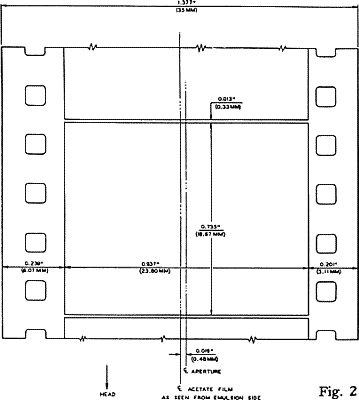CinemaScope attachment in one housing and the complete arrangement has been designed as one optical system for optimum performance. Such a lens, mounted on a camera, is illustrated in Figure 4. Figure 5 shows the various Bausch & Lomb lenses now available, which are 35mm, 40mm, 50mm, 75mm, and 100mm. In addition there recently became available a 152mm lens which is particularly suitable for background projection photography.
![]() In normal practice the usual lenses used are the 40mm and 50mm
and other lenses are used for the same reasons that they are employed
in regular photographic practice - the longer lenses being used for closeups, telephoto effects and the like. With this understanding of the
lenses, and the following examples, it will be clear that sets need not be
built as high nor any wider than formerly.
In normal practice the usual lenses used are the 40mm and 50mm
and other lenses are used for the same reasons that they are employed
in regular photographic practice - the longer lenses being used for closeups, telephoto effects and the like. With this understanding of the
lenses, and the following examples, it will be clear that sets need not be
built as high nor any wider than formerly.
![]() For instance, let us imagine that we want to photograph a small
office set. With the older method we would have probably used a 25mm
lens in order to keep within the walls. Suppose the action required a
person to enter from a door in the foreground and go toward the rear
and sit down at a desk. With the old technique, a ceiling piece would
probably have been required to back up the person when they were in
the foreground and the camera would pan to hold on the desk. The
same scene when filmed with a CinemaScope lens, although
photographed from approximately the same set-up with a 50mm lens,
would not require the ceiling as the vertical angle of the scene is now
less; however, the horizontal angle is the same as before. Rather than
pan the camera to hold the character center we would likely stay fixed
and take advantage of stereophonic sound recording to enhance the
actor movement as the sound moved with him in a natural way.
Furthermore, the size of the figure in the rear of the set would not be so
diminished because of the perspective drawing of the 50mm lens used
as compared to the 25mm lens in the older method, therefore making it
unnecessary to shoot a close-up angle. If it were the intention, in the
scene,
For instance, let us imagine that we want to photograph a small
office set. With the older method we would have probably used a 25mm
lens in order to keep within the walls. Suppose the action required a
person to enter from a door in the foreground and go toward the rear
and sit down at a desk. With the old technique, a ceiling piece would
probably have been required to back up the person when they were in
the foreground and the camera would pan to hold on the desk. The
same scene when filmed with a CinemaScope lens, although
photographed from approximately the same set-up with a 50mm lens,
would not require the ceiling as the vertical angle of the scene is now
less; however, the horizontal angle is the same as before. Rather than
pan the camera to hold the character center we would likely stay fixed
and take advantage of stereophonic sound recording to enhance the
actor movement as the sound moved with him in a natural way.
Furthermore, the size of the figure in the rear of the set would not be so
diminished because of the perspective drawing of the 50mm lens used
as compared to the 25mm lens in the older method, therefore making it
unnecessary to shoot a close-up angle. If it were the intention, in the
scene,

Fig. 2